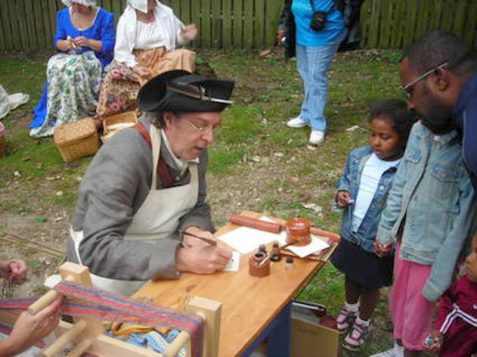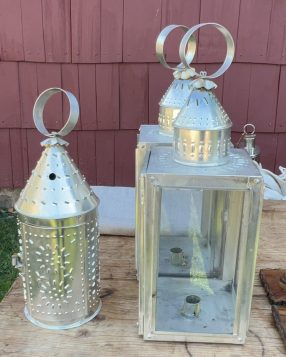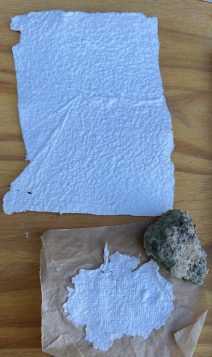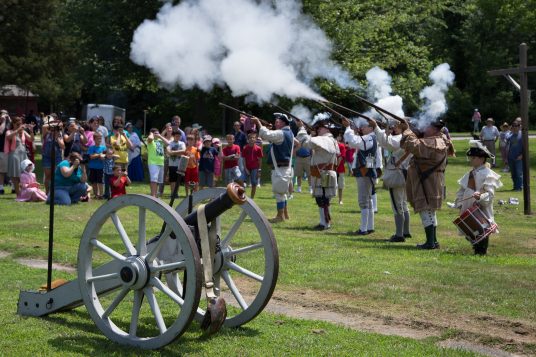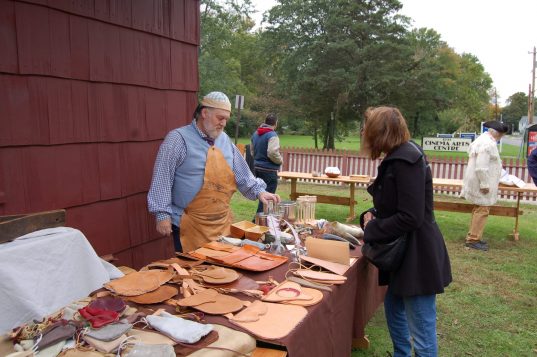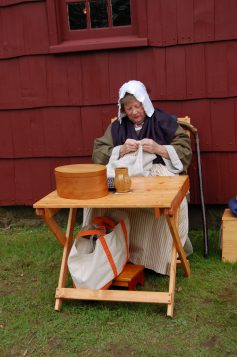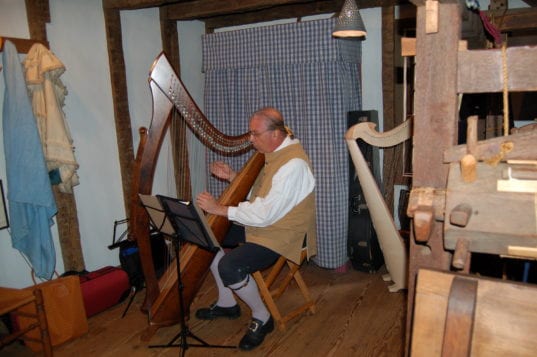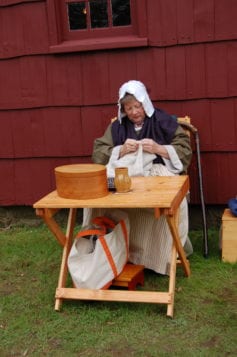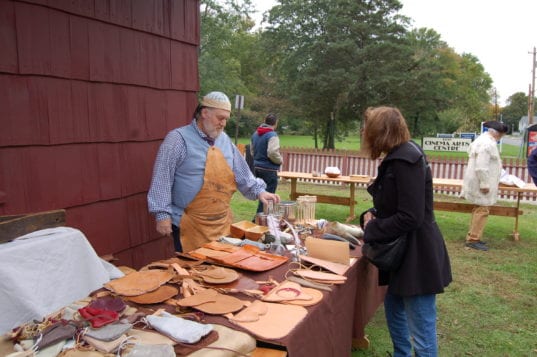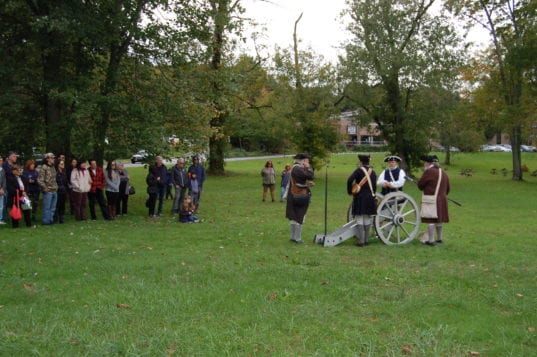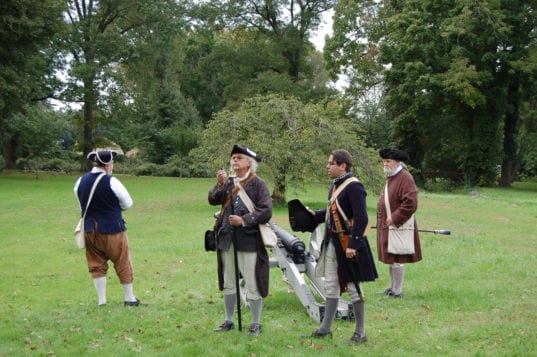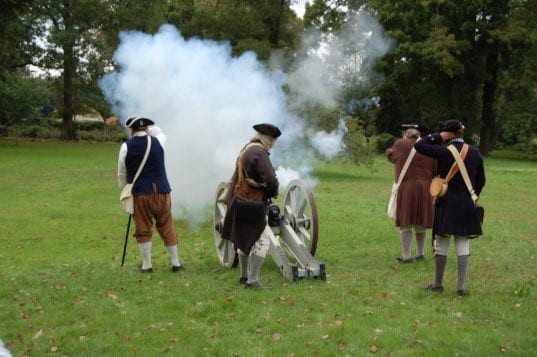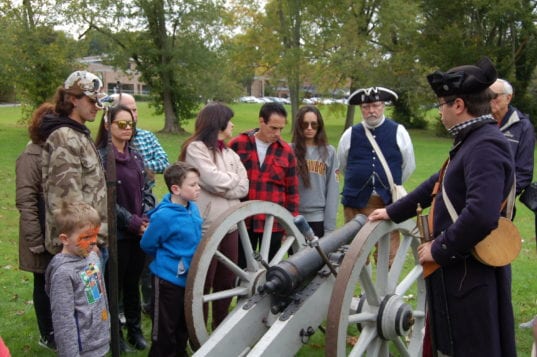By Jennifer Donatelli
The year is 1775 and there’s been turmoil in all of the colonies. At least, that’s what it felt like for visitors at the Huntington Militia Group’s annual Fall Muster Day last Sunday, Oct. 20, at The Arsenal, part of the Sammis House, at The Village Green in Huntington.
The Militia Group recreated life in the 18th century with live, hands-on demonstrations through the day of civilian and military life in the 1700s.
Attendees witnessed live musket and cannon drills throughout the day, as well as witnessing them being fired from The Arsenal. This was all part of living history that the Militia Group uses to educate the community of what life was like in Colonial America in Huntington. All volunteers were dressed in period clothing they sewed themselves.
Patrick Mantle, commander of the Huntington Militia, said the event promotes family participation with the live demonstrations and provides a wide range of educational activities. He explained, “It’s like American history textbooks coming alive.”
In addition to a variety of colonial crafts, visitors learned about silversmithing, paper making, sewing, cooking, embroidery, weaving and even how to load and shoot a musket.
One of the highlights of the day for kids was the Children’s Musket Drill where kids — and adults — were taught to march, drill and fire “practice muskets.” Noah, age 8, from Huntington thought it was “so cool.” His older sister Elyse agreed, saying, “It made me really want to learn more about the history of the colonists.”
Papermaking, silver jewelry, embroidery and muskets
Patricia Roos, one of the volunteers and a former teacher, talked about the importance of papermaking while she demonstrated the process. She explained that paper was too expensive to buy because it was being imported from England and was heavily taxed by the British. Paper was an important commodity because it was used for writing letters, as cartridges for guns and writing books.
The colonists wound up teaching themselves how to make paper from natural materials like linen or cotton from their clothes. Roos said, “The colonists would wear out their clothing until it became rags and then sell it to a ragman.” She added, “The ragman would turn around and sell the clothing rags to a factory where they would chop up the fabric into little tiny pieces, put it in a barrel with water to make a pulp.” Using a screen and pressing out the water, the soon-to-be paper would hang to dry for 24 hours.
Volunteer and silversmith, Michael Goudket, makes silver jewelry from coins — a trade he said the colonists carried out during the early 1700s. He added that Native Americans would trade beaver pellets for silver jewelry. The Native Americans would use the silver crosses as decorative and shiny pieces on their clothing.
Goudket explained, “Silversmiths were an intricate part of the community because in colonial times, when you brought your money to the bank they charged you to have a man stand with a gun and guard it.” He added, “People would bring their coins to the silversmith who would turn them into plates and tankards writing the owner’s initials on them so they couldn’t be stolen.”
Goudket said he learned silversmithing while a student at Syracuse University. “It was part of my fine arts curriculum,” he said. “I have been silversmithing ever since.” He explained that a silversmith would take silver coins and hammer them out to make sheets of silver that would be used to trade for beaver pellets, which were needed to make fur hats.”
Robert and Merrell, a husband-and-wife team who did not wish to disclose their last name, have been volunteering for years with the Huntington Militia Group. Merrell explained the importance of embroidery, while showing visitors how to use the embroidery needles to make dining room chair covers from the 1700s. She said, “Ladies did all the embroidery because it was a luxury that required leisure time and a lot of money.
Robert demonstrated how cord would be used in colonial times in lacing a corset or for a woman to use cord to tie her apron. He said, “It may have been done by the ladies, children or older people in the house to give them something to do.”
Robert said he learned the art of lucet when he went to visit the Jamestown settlement in Virginia. He observed a woman making cord and said, “When I got home I went to the library and found a book on an 18th-century lucet and began from there.” He has written a reference pamphlet on the subject so the tradition can carry on.
Attendees got to see first-hand how Revolutionary War soldiers were able to load and shoot a .75 caliber rifle. Artillery volunteer, Vinny DeNardo, explained that a regular rifle only had the capability to shoot 65 to 75 yards but a gun-powdered musket can load in 20 seconds and could shoot across three football fields, instantly killing a British officer with only one shot.
Huntington Militia
The Ancient and Honorable Huntington Militia is one of the oldest organizations in the United States. It was formed in 1653 by the Town of Huntington to provide an effective defense against the hostile Dutch settlements of New Netherlands and to keep the local Native Americans in awe by holding regular, public training exercises on the Town Common. Huntington was made part of the Colony of New York in 1664 and the Huntington Militia became part of the New York Provincial forces in 1666.
The Huntington Militia was reactivated by The Town of Huntington in 1974, to serve in a ceremonial capacity as its official Colonial Guard and to continue as a permanent, living link with the town’s proud heritage. The militia became a Revolutionary War reenactment unit in 1976 and continues to this day to preserve its heritage and recreate life as it was on Long Island in Colonial America.
For more information on upcoming events, or to volunteer, visit the website www.huntingtonmilitia.com.

